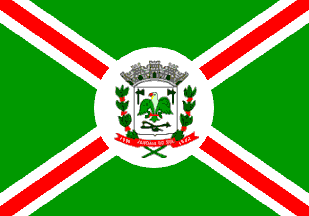 7:10 image by Joseph McMillan
7:10 image by Joseph McMillan
Last modified: 2022-03-05 by ian macdonald
Keywords: brazil | parana | jandaia do sul | parakeet | axe |
Links: FOTW homepage |
search |
disclaimer and copyright |
write us |
mirrors
The municipality of Jandaia do Sul (21,122 inhabitants in 2018; 18,760 ha) is
located 400 km north-west of Curitiba.
Jandaia do Sul was established in
1942 by Companhia de Terras Norte do Paraná in the New North during the coffee
boom.
The district of Jandaia was established in 1949, to be elevated a
municipality by State Law No. 790 promulgated on 14 December 1951, separating
from Apucarana. The municipality was inaugurated on 14 December 1952.
Jandai
is named for the janday parakeet, _Artinga jandaya_ Gmelin (1788), locally known
as "jandaia".
Do Sul (Southern) was added to the municipality's name for the
sake of differentiation from the municipality of Jandaia, located in the state
of Goiás.
https://www.jandaiadosul.pr.gov.br/
Municipal website
The flag
and arms of Jandaia do Sul are prescribed by Municipal Law No. 752 promulgated
on 5 May 1972.
Article 6.
The municipal Flag of Jandaia do Sul,
designed by heraldist Arcinóe Antônio Peixoto de Faria, shall be divided per
saltire in green quarters composed by four white stripes superimposed with
copper-red stripes, arranged two by two in bend and bend sinister, starting from
a central white circle inscribing the municipal coat of arms.
§1. In
compliance with the tradition of Portuguese heraldry, whose canons and rules
were inherited, municipal flags shall be divided into eight, six, four or three
parts, using the colors of the field of the coat of arms, and displaying in the
center or at hoist a geometric figure inscribing the municipal coat of arms.
§2. The municipal flag of Jandaia do Sul obeys this general rule, being
quartered in saltire [redundant description skipped].
§3. The coat of arms
applied to the flag, represents the municipal government while the white circle
inscribing it represents the town as the seat of the municipality; the circle is
a symbol of eternity, because it is a geometrical figure that has no beginning
and no end; the white color symbolizes peace, friendship, work, prosperity,
purity, and religious spirit. The white stripes superimposed with red stripes,
which start from the central circle and quarter the flag, represent the spread
of the municipal power to all parts of the territory; the red color symbolizes
patriotic love, dedication, audacity, intrepidity, courage, and bravery. The
green quarters thus constituted represent the rural properties existing in the
municipal territory; the green color is a symbol of honor, civility, courtesy,
abundance, joy and hope; hope is green, because it recalls greening fields in
spring promising a profuse harvest.
Article 7.
In compliance with the
heraldic rules, the municipal flag shall have the official dimensions prescribed
for the national flag, 14 units in width on 20 units in length.
Article
19.
The coat of arms of Jandaia do Sul, heraldically revised by heraldist
Acides Antônio Peixoto de Faria, is described in heraldry language as follows.
A Samnite shield, surmounted by a six-towered mural crown argent. A field argent
charged in the center with a janday parakeet, with wings spread and pulled on a
branch gules leaved vert. The chief cantonned with two axes sable in base a plow
of the same.
The shield supported dexter and sinister by coffee branches
fructed proper crossed in base and superimposed by a scroll gules containing the
toponym "JANDAIA DO SUL" in letters argent flanked by years "1942" and "1952".
The coat of arms has the following symbolic interpretation:
a) The
Samnite shield used to represent the arms of Jandaia do Sul was the first style
of shield introduced in Portugal by French influence, inherited by Brazilian
heraldry as evocative of the colonizing race and the main builder of the nation.
b) The mural crown that surmounts it is the universal symbol of domains' coats
of arms; argent (silver), with six towers, only four of them visible in
perspective view, it classifies a 3rd rank town, that is, the seat of a
municipality.
c) Argent (silver) is the heraldic symbol of peace, friendship,
work, prosperity, purity, and religious spirit.
d) The jandya parakeet (green
parakeet with a yellow beak) makes the arms canting, as the origin of the name
of the town.
e) Vert (green) is the symbol of honor, civility, courtesy,
abundance and joy, while gules (red) symbolizes dedication, patriotic love,
intrepidity, audacity, courage, and valiance.
f) The axes sable (black) in
chief (upper part of the shield) represent clearing and colonization of the
ubiquitous lands of North Paraná, promoted by the then Companhia de Terras Norte
do Paraná, today Companhia Melhoramentos Norte do Paraná, who conceived and
executed the gigantic plan for clearing and colonizing the region, which earned
it the nickname "Town Planter", including the town of Jandaia do Sul.
g) The
plow sable (black) in base (the point of the shield) indicates that the
municipality's income is based on agriculture, thanks to the exuberance of the
land.
h) Sable (black) is a symbol of fertility, prudence, wisdom,
moderation, and austerity.
i) The fructed coffee branches represent the main
product of the generous and fertile land.
j) The toponym "Jandaia do Sul" is
inscribed on the scroll gules (red) in letters argent (silver), flanked by the
years, "1942" for its foundation, and "1952" for its political emancipation.
https://leismunicipais.com.br/a/pr/j/jandaia-do-sul/lei-ordinaria/1972/76/751/lei-ordinaria-n-751-1972-dispoe-sobre-a-forma-e-a-apresentacao-dos-simbolos-do-municipio-de-jandaia-do-sul-e-da-outras-providencias
Leis Municipais database
Photos
https://jandaiadosul.pr.gov.br/documentos/imgnoticia/4354.jpg
https://www.jandaiadosul.pr.gov.br/index.php?mod=988&idNot=988
https://www.facebook.com/Prefeituradejandaiadosul/photos/1832289113632195
Ivan Sache, 3 February 2022